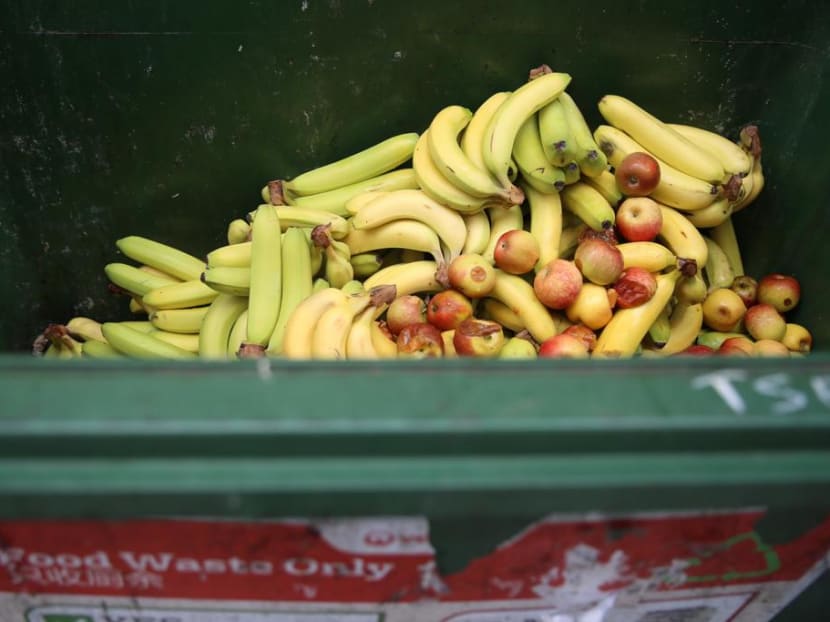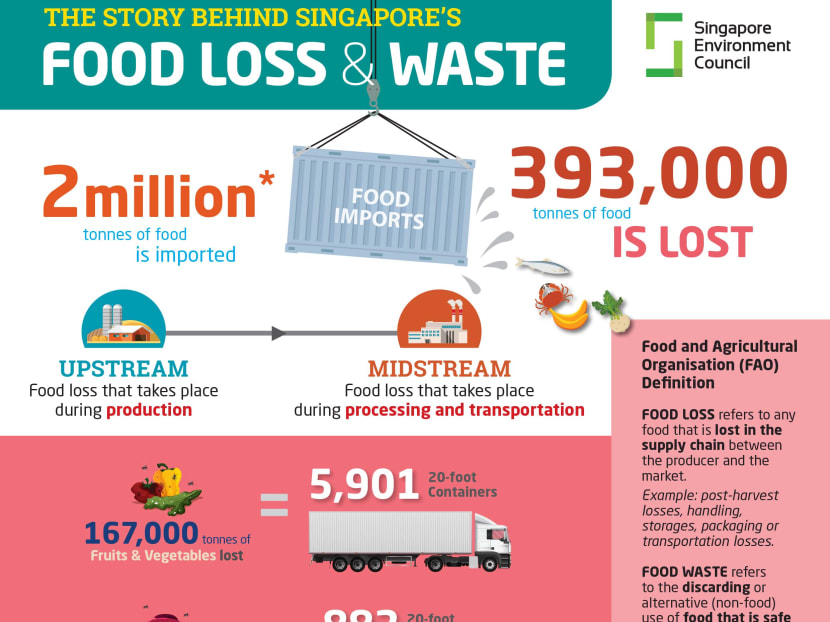Every Singaporean household throws away an average S$258 worth of food a year: Study
SINGAPORE — Even though Singapore prides itself on all things culinary, a new study has found that each household here throws away an estimated S$258 worth of unconsumed food annually.

Fruit and vegetables are among the top items involved in food waste in Singapore, according to a new study published on Tuesday (Aug 6).
SINGAPORE — Even though Singapore prides itself on all things culinary, a new study has found that each household here throws away an estimated S$258 worth of unconsumed food annually.
Across all households, that amounts to about S$342 million of wasted food a year. Put another way, an average household tosses away the equivalent of 52 plates of nasi lemak over 12 months.
The study, published on Tuesday (Aug 6), was conducted by the Singapore Environment Council (SEC), and looked at both household food waste, and the large amount of food lost before it ever gets to the customer — during production, packaging and storage, for example.
Two million tonnes of food is imported into Singapore, of which 393,000 tonnes is lost.
The biggest volume of food loss involves fruit and vegetables, while Singapore’s egg farmers generate the least waste due to their well-developed and efficient supply chain and the use of modern technology.
“Local farmers can look to egg producers here as a role model to achieve the same high level of efficiency,” said the SEC on Tuesday, as it unveiled the findings of the study conducted with financial advisory firm Deloitte.
“This is the first time … we have conducted an intensive six-month study to … review the food loss and food waste in the entire food chain (in Singapore),” said the SEC’s chairman, Ms Isabella Huang-Loh.
According to the United Nations’ Food and Agricultural Organisation (FAO), “food loss” refers to any food lost in the supply chain, while “food waste” refers to the discarding or non-food use of products that are safe and nutritious for human consumption.

'USE BY' 'BEST BEFORE' AND 'EXPIRY' NOT WELL UNDERSTOOD
Data collected from 1,002 respondents through an online survey found that 26,000 tonnes of unconsumed food are thrown away from households in Singapore annually.
The study said that this is largely a result of improper storage, purchasing patterns and food handling habits.
About a third of the consumers surveyed indicated they would generally throw away 10 per cent or more of uncooked and unconsumed food items per week.
One factor is that 80 per cent of the respondents do not fully understand the difference between various labels such as “use by”, “best before” and “date of expiry” used on product packaging.
SEC’s executive director, Ms Jen Teo, said it is possible to stretch products by a “few weeks” if they have passed their “use by” or “best before” dates, though items that have passed their “expiry” dates should be discarded.
Added Mr Rayson Ng, Deloitte’s sustainability leader: “If we can discern between different types of labels, that will lengthen the amount of time to consume the food, and that will probably minimise food waste.”
On the flip-side, the study found that 20 per cent of respondents could be classified as “smart consumers”.
They are consumers who generally:
Do not throw away unconsumed food
Are effective and organised planners, who always or often make a shopping list
Are not swayed by promotional offers to buy excess food items that are potentially wasted
Make sure they consume all food items bought, and do not buy more than they need
Shop at least once a week without contributing to an increase in food waste

FOOD LOSS BEGINS BEFORE IT REACHES CONSUMERS
The 393,000 tonnes of food lost during production, processing and transportation here is equivalent to 62kg worth of food per person in Singapore.
For locally produced food, the study found that more than 5,000 tonnes is lost at production, and close to 2,000 tonnes of food is lost during post-harvest handling and storage.
During the processing and packaging stage of imported and locally produced food items, the SEC said food loss is close to 75,000 tonnes, with another 116,000 tonnes of food loss during distribution.
Of 342,000 tonnes of food loss incurred in Singapore, top of the list were:
167,000 tonnes of fruits and vegetables
25,000 tonnes of fish and seafood
5,500 tonnes of eggs
Some of the key drivers of food loss identified in the study are:
Poor disease and pest management
Over-importation of food items
Fragmented cold chain management
Inadequate infrastructure
TREATING PERISHABLE FOODS CAREFULLY
While Singapore needs to address the issue of its food security, Ms Teo questions whether the Republic really needs to import “that amount of food”.
“Rather than over-import, let’s divert these resources and cost to growing locally.”
She said that if Singapore can encourage local food producers to flourish with the use of better technologies, there will not only be less food waste, but “fresher food” for consumers.
Touching on “fragmented” cold chain management, Ms Huang-Loh said that some “antiquated” methods of transporting perishable foods in Singapore have to change as well.
For example, more sophisticated methods of transporting fish were needed, rather than just covering the fish with ice.
The same can be said for “highly perishable” items such as fruit and vegetables, added Mr Ng.
He said that these are “low-value” products, so wholesalers and distributors are not willing to invest in proper cold chain management. “As a result, the transportation itself would contribute to the food loss.”
Speaking to TODAY, Mr Joe Chen, the chief commercial officer of local fresh produce company Glife Technologies agreed that more can be done by the various players within the food industry to reduce wastage.
Mr Joe Chen said that his company ensures that their perishable produce is kept chilled throughout the entire process.
Regardless of whether the produce comes from the Cameron Highlands in Malaysia, or from one of the local farms, Mr Chen said it is transported in vehicles with a refrigerated space.
“There’s no point buying cheaply and discovering it’s rotten upon arrival.”
Even when they are getting ready to pack the produce for their customers, Mr Chen said that they will do it within an air-conditioned space. “We want to keep our products at the right temperature.”
He added that many wholesalers take it out of cold storage and put the produce either under the hot sun or at room temperature during packing and loading.
“The products will have a lot of condensation and they will spoil,” he said.
A SHIFT IN MINDSET TO BUY LESS FOOD
One consumer said it also helps to have a shift in mindset when purchasing groceries, even if it means that paying a higher price for not buying in bulk.
Mr Shaun Ho, a father of two, said that since the start of the year, he has been making a conscious decision to buy just enough for his family when he shops.
The 33-year-old, who works in logistics, said that he used to make his purchases according to the promotions offered at the supermarkets.
For instance, whenever a promotional discount was offered to shoppers whenever they buy two cartons of milk, he would do it even if he did not need that much at home.
“I always can’t finish and I end up throwing away about 60 to 90 per cent of the second carton of milk,” he said.
“I don’t like the idea that I’m throwing away more than half of unopened things that have spoiled from sitting in my pantry for too long.”
Another suggestion to reduce food waste, suggested Ms Huang-Loh, is selling aesthetically unappealing food at a lower price point at specialty stores.
This “ugly food”, which would typically be tossed out by supermarkets, is still safe for consumption, she said.
Mr Ng said if Singapore can cut down on food loss, and channel it into food for consumers, it could create the Republic’s “fourth food basket” – after food imports, locally grown food, and the sourcing of cheaper food alternatives from overseas.











